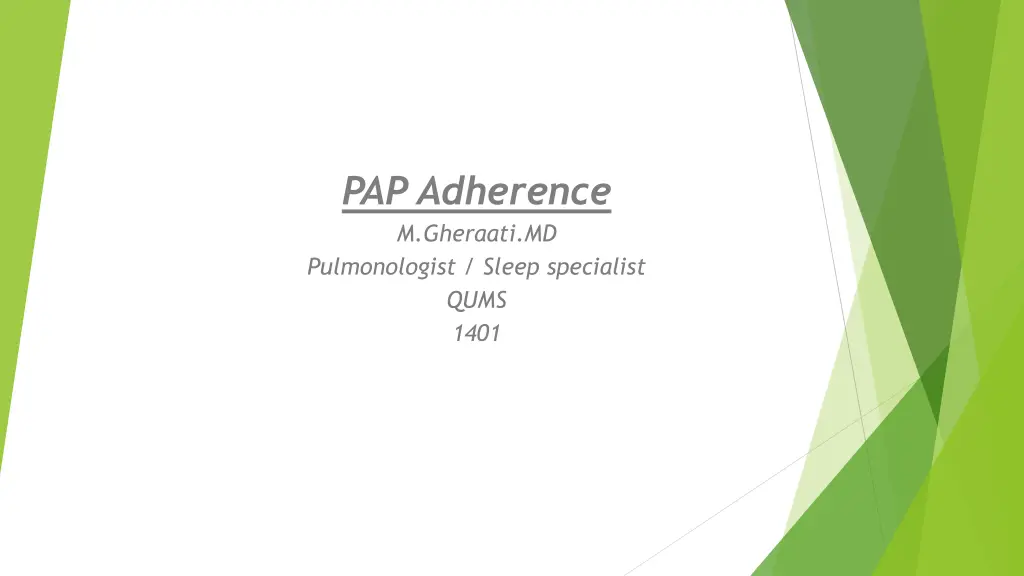
Improving Patient Adherence in PAP Treatment: Factors and Importance
Ensuring patient adherence in PAP treatment is crucial for success. Factors influencing adherence, such as data from PAP devices, adverse effects, and symptomatic improvement, play a significant role. Adherence rates vary and early adherence predicts long-term use. Studies show better adherence in patients with higher AHI, and heated humidification benefits those with nasal symptoms. Adherence thresholds for improved outcomes are identified, regardless of the study protocol.
Download Presentation

Please find below an Image/Link to download the presentation.
The content on the website is provided AS IS for your information and personal use only. It may not be sold, licensed, or shared on other websites without obtaining consent from the author. If you encounter any issues during the download, it is possible that the publisher has removed the file from their server.
You are allowed to download the files provided on this website for personal or commercial use, subject to the condition that they are used lawfully. All files are the property of their respective owners.
The content on the website is provided AS IS for your information and personal use only. It may not be sold, licensed, or shared on other websites without obtaining consent from the author.
E N D
Presentation Transcript
PAP Adherence M.Gheraati.MD Pulmonologist / Sleep specialist QUMS 1401
The major challenge of PAP treatment is to ensure that patient adherence to treatment is adequate . Today, PAP machines have both internal memory and removal memory (smart cards, SD cards, flash drives) . The data obtained from PAP devices often also include useful information on leak as well as an estimate of the residual AHI.
Adherence rates are defined in many ways : the percentage of days used the average use all days (averaging in 0 hours for days not used) average nightly use (days used) the percentage of nights used greater than 4 hours
Factors influencing adherence and importance of early adherence
A study found that the adverse effects of CPAP on sexual intimacy may be a major problem for some patients. If a bed partner reacts negatively to CPAP this may have a negative effect on adherence .
In some studies, patients with a higher AHI or worse arterial oxygen desaturation showed better adherence. In general, if patients note a symptomatic improvement, this is positive reinforcement for CPAP use . Heated humidification is likely to have the most benefit in patients with symptoms of nasal congestion and dryness. Early adherence is a good predictor of long-term PAP use.
Whether CPAP treatment follows a split night (diagnostic or PAP titration) or separate diagnostic and PAP titration studies does not seem to affect PAP adherence.
How much adherence is enough? Thresholds of the duration of nightly PAP use above which significant improvement was noted were identified for the Epworth Sleepiness Scale (ESS) (4 hr), multiple sleep latency test (6 hr), and quality of life (assessed by Functional Outcomes of Sleep Questionnaire) (7.5 hrs). The necessary amount of PAP usage depends on which outcome is being evaluated.
The current Centers for Medicare and Medicaid (CMS) guidelines state that devices will be reimbursed after 12 weeks only if objective adherence for a period of at least 1 month shows >4 hours use per night for 70% or more of nights and the treating physician documents in a face-to-face meeting that the patient is benefiting from PAP treatment .
Interventions to improve adherence
Nasal congestion may be a significant issue. This problem may be addressed with nasal steroids, antihistamines (oral and topical), increased humidity, or reduced mask leak (tends to remove humidity from the system). Studies have demonstrated that loss of humidity via a leak can dramatically increase nasal resistance. If a patient reports worsening nasal congestion as the night progresses, suspect leak as the problem. If mouth leak is occurring, a chin strap or oronasal mask may be used.
Bloating may respond to lowering of pressure or switch to auto-PAP (APAP) or BPAP. Rhinitis or rhinorrhea may respond to nasal ipratropium bromide. More information about heated humidity and interventions for pressure intolerance is presented.
For pressure intolerance: -- use of a lower pressure -- the addition of flexible CPAP -- a change to APAP or BPAP -- education about using the ramp
Cognitive behavioral treatment of insomnia is another option
